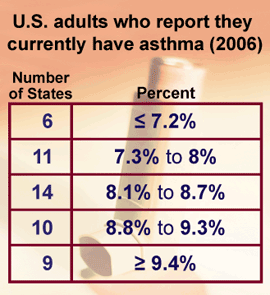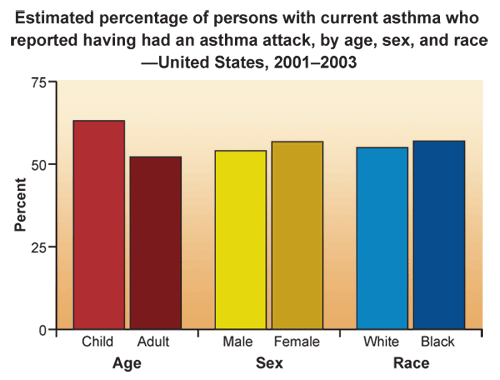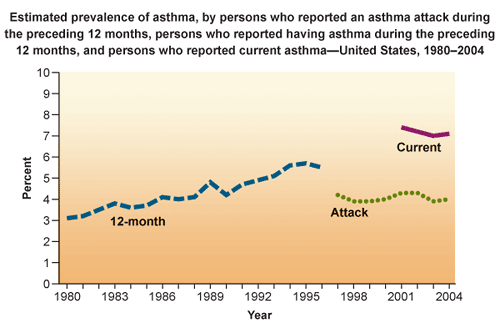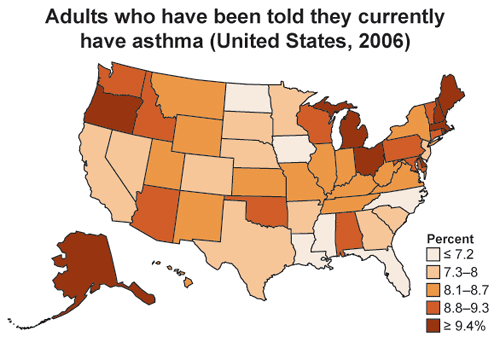Data & Statistics
May is Asthma and Allergy Awareness Month

May is Asthma and Allergy Awareness Month, and May 6, 2008, marks the 10th annual observance of World Asthma Day. To raise awareness about asthma, CDC is highlighting asthma information provided by CDC’s Air Pollution and Respiratory Health Branch and Behavioral Risk Factor Surveillance System.
Asthma is a major public health problem of increasing concern in the United States. CDC conducts surveillance on asthma in several ways, including collecting data on state-level adult asthma prevalence rates; days of restricted activity, days in bed, days of work or school lost, physician visits, and hospitalizations due to asthma; and collecting in-depth state and local asthma data through development and testing of a National Asthma Survey.
CDC’s analyses of asthma data on the national level show that between 1980 and 1995, the 12-month prevalence of asthma in the United States increased from 2.9% to 5.0% among adults and from 3.5% to 7.5% among children. Although there has been no discernable change in asthma attacks since 1997 or in current asthma prevalence from 2001 to 2004, low-income populations, minorities, and children continue to experience disproportionately higher morbidity and mortality attributable to asthma. Additionally, as the figure below shows, for the 3-year period 2001–2003, higher percentages of children than adults who currently have asthma reported having had an asthma attack. The small differences between males and females and between blacks and whites are not significant.
From 2001–2003, an average of 4,210 deaths were associated with asthma annually, with approximately 50% occurring among persons aged 65 years or younger. In 2005, an estimated
• 32.6 million Americans had been diagnosed with asthma during their lifetimes;
• 22.2 million Americans currently were diagnosed with asthma; and
• 12.2 million Americans experienced an asthma attack in the previous year.

Each year, an average of 504,000 Americans are hospitalized for asthma-related symptoms. In 2004, in the United States asthma accounted for
• 13.6 million doctor visits;
• 1.1 million hospital outpatient visits; and
• 1.8 million emergency department visits.
During 2001–2003, current asthma prevalence was higher for children (8.5%) than for adults (6.7%); it was also higher for females (8.1%) than for males (6.2%); for blacks (9.2%) than for whites (6.9%); for those of Puerto Rican descent (14.5%) than for those of Mexican descent (3.9%); for those below the federal poverty level (10.3%) than for those at or above the federal poverty level (6.4% to 7.9%); and for those residing in the Northeast (8.1%) than for those residing in other regions (6.7% to 7.5%).
Among children under 18,
• Physician office visits due to asthma have increased from under 40 visits per 1,000 children in 1990 to 89 visits per 1,000 in 2004.
• The asthma death rate increased steadily between 1980 and 1998, but it has declined since, falling from 3.0 deaths per 1,000,000 in 1999 to 2.5 per 1,000,000 in 2004.

Annually, among those who report at least one asthma attack in the previous year, approximately 11.8 million days of work absences are attributed to asthma, as are approximately 14.7 million days of school absences.
An important way that CDC collects data on state-level prevalence rates of asthma in adults is through the Behavioral Risk Factor Surveillance System (BRFSS).BRFSS data are collected by telephone survey from adults age 18 and older about a variety of health-related behaviors. Since 2000 the survey has included two questions related to asthma:
• Have you ever been told by a doctor, nurse, or other health professional that you had asthma?
• Do you still have asthma?
Current asthma is defined by a “yes” response to both of the asthma questions, meaning these adults report previous physician-diagnosed asthma and also report they still have asthma.
Geographic Information System (GIS) maps can be generated from the BRFSS website at http://apps.nccd.cdc.gov/gisbrfss/default.aspx to show the results of the BRFSS survey.Following is the GIS map produced for the BRFSS data set for asthma for 2006.

In six states (Florida, Iowa, Louisiana, Mississippi, North Carolina, and North Dakota), 7.2% or fewer of surveyed adults reported current asthma.In thirty-five states, 7.3% to 9.3% of adults reported current asthma. In nine states (Alaska, Delaware, Maine, Massachusetts, Michigan, New Hampshire, Ohio, Oregon, and Rhode Island), 9.4% or more of those surveyed reported current asthma.
For More Information
- CDC Asthma site
- CDC Asthma and Allergies
- Basic Asthma Facts: You Can Control Your Asthma
- Behavioral Risk Factor Surveillance System (BRFSS)

World Asthma Day, an annual awareness-raising event organized and sponsored by the Global Initiative for Asthma*
Page last updated: May 1, 2008
Content Source: National Center for Chronic Disease Prevention and Health Promotion,Division of Adult and Community Health andNational Center for Environmental Health,Division of Environmental Hazards and Health Effects
Content owner: National Center for Health Marketing
URL for this page: www.cdc.gov/Features/dsAsthma
*Links to non-federal organizations are provided solely as a service to our users. These links do not constitute an endorsement of these organizations or their programs by CDC or the federal government, and none should be inferred. CDC is not responsible for the content of the individual organization Web pages found at these links.


